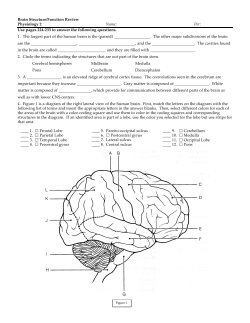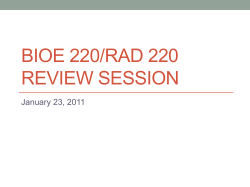
Session 2 - Department of Psychology
The hippocampus is involved in memory for recently learned, but not highly familiar environments Hirshhorn, 1 1,2 M. , Moscovitch, 1,2 M. , Grady, 2 C.L. , Rosenbaum, 2,3 R.S. , Winocur, 2 G . Department of Psychology, University of Toronto, Toronto, ON, Canada, 2 Rotman Research Institute, Toronto, ON, Canada, 3 Department of Psychology, York University, Toronto, ON, Canada Results Continued Results Introduction •There is much evidence to support a role for the hippocampus in learning the layout of a new environment; however, it’s role in the long-term storage and retrieval of such memories is disputed. Comparison Across Sessions ROI Analysis of the Right Hippocampus 100 90 80 70 0.1 60 •Some studies report hippocampal activation (Spiers & Maguire, 2006) whiles other studies do not report hippocampal activation during mental navigation tasks (Rosenbaum et al., 2004) Session1 50 Session2 40 * 0.08 0.06 30 Session 1 0.04 20 10 Session 2 0.02 0 •The current study aims to test the hypothesis that a spatial representation of a large-scale environment, that is sufficient to support mental navigation, can exist independently of the hippocampus. In particular, we wish to test the idea that spatial representations that are initially dependent on the hippocampus can become independent of the hippocampus over time. Dist Prox Route 0 Figure 1. Accuracy data for the three mental navigation tasks is shown for the eight participants who were available for both sessions. -0.02 1 Figure 4. Mean percentage signal change in the right hippocampus for sessions 1 and 2. (p< 0.005) Session 1 (N=13) Conjunction analysis across tasks Disjunction Analysis: Activations unique to Session 2 •To test this hypothesis, we compare brain activation during mental navigation tasks in a large-scale environment, downtown Toronto, at two time-points: once when participants are newly-arrived to Toronto, and after a year of living and navigating within the city. Methods Participants Session 1 • Thirteen participants (5 male; mean age 26.7 yrs, SD = 4.0; 2 left-handed) who had less than one year of experience living and navigating in downtown Toronto Session 2 •Eight participants from the initial set (1 male; mean age X years; 1 left-handed) repeated the experiment after one year of living and navigating in downtown Toronto Toronto Public Places Test •Task 1: Distance judgments. Estimate the distance between two landmarks. (< 2.5 km < ?) •Task 2: Proximity judgments. Select which of two landmarks is closest to a reference landmark. •Task : Blocked-route navigation. Imagine an alternative route between two landmarks if the most direct route is blocked. Figure 2. The right hippocampus and left precuneus are activated by all three mental navigation tasks in session 1. Region R middle temporal gyrus R hippocampus R fusiform gyrus R parahippocampal gyrus L middle temporal gyrus L superior temporal gyrus L supramarginal gyrus R precentral gyrus L middle frontal gyrus L inferior frontal gyrus L superior frontal gyrus L precuneus R postcentral gyrus x L postcentral gyrus R cuneus y z 53 31 41 -34 -54 -57 -66 45 -25 -57 -21 -11 11 60 -10 15 -53 -23 -36 -14 0 -20 -49 -10 33 27 20 -50 -39 -24 -38 -91 7 -9 -17 -16 -10 -1 25 57 40 4 62 32 70 37 68 32 volume t-stat 6550 2.77 505 2.77 501 3.45 295 1.75 158 2.20 136 2.21 4623 3.33 1607 2.19 942 2.51 137 2.20 133 2.39 1567 3.00 611 2.19 103 2.33 108 2.23 1698 2.46 Table 1. Regions of common activation in all three mental navigation tasks (p<0.000125) 2 sec < 2.5 km < ? Session 2 (N=8) Conjunction analysis across tasks + Museum Figure 3. The right parahippocampal gyrus and right precuneus are activated by all three mental navigation tasks in session 2. Data Analysis •AFNI, version 2.0 software package •Head motion correction, physiological motion correction, signal normalization •Activation maps were transformed to Tailairach coordinates & smoothed with a Gaussian filter of 6-mm FWHM Region R middle frontal gyrus (BA 6) L middle frontal gyrus (BA 6) R medial frontal gyrus (BA 10) R inferior frontal gyrus L inferior frontal gyrus (BA 47) R precentral gyrus R superior frontal gyrus (BA 10) L superior frontal gyrus (BA 6) L cingulate gyrus R middle temporal gyrus L middle temporal gyrus (BA 21) R superior temporal gyrus (BA 38) L superior temporal gyrus (BA 38) R parahippocampal gyrus L inferior temporal gyrus R insula L insula (BA 13) L caudate L superior parietal lobule R paracentral lobule (BA 6) x 32 -28 -41 -47 5 9 48 37 -22 41 20 -4 -17 52 -58 48 -47 23 -52 35 -43 -1 -15 -34 8 y 14 20 46 41 66 51 29 35 32 -12 66 27 -33 -32 -27 15 19 -41 -18 14 -5 15 20 -68 -29 z volume t-value 58 2949 1.52 54 6100 1.47 -4 153 0.7 17 72 0.726 8 2808 0.97 -17 53 1.13 5 255 1.02 -1 79 0.709 -5 11411 1.833 58 865 1.607 14 98 0.826 64 406 1.29 25 1053 0.96 1 541 0.91 -1 697 1.12 -10 56 0.9 -19 247 0.8 0 304 0.72 -21 141 1.1 0 60 0.77 1 314 1.23 7 682 1.54 10 54 0.92 55 746 1.07 66 70 0.71 Table 2. Regions of common activation in all three mental navigation tasks (p<0.005) TEMPLATE DESIGN © 2008 www.PosterPresentations.com x 3 -23 y -66 -58 z volume t-stat 0 464 0.79 -4 300 1.00 2 59 -4 148 0.74 -21 26 -20 36 36 -98 -5 3 0 136 72 129 1.29 0.54 0.64 Table 3. Brain regions that were active during session 2, but not session 1 (p< 0.001). Conclusion •We document a significant decrease in right hippocampal activation during the performance of mental navigation tasks, as participants gained familiarity with the downtown Toronto environment over a one year period. •Consistent activation over time was observed in a network of brain regions commonly implicated in mental navigation, including the cuneus/precuneus, middle and superior temporal gyri, and medial frontal cortex. 8 sec Image Acquisition •Participants were scanned with a GE Signa 3 Tesla MRI scanner. •Anatomical: 3D T1-weighted pulse sequence image (124 axial slices, 1.4 mm thick, FOV = 22 cm). •Functional: single-shot T2*-weighted pulse sequence with a spiral readout (26 axial slices, 5 mm thick, TR = 2000, TE = 30 ms, flip angle = 30 degrees, FOV = 20 cm). Region R lingual gyrus L parahippocampal gyrus R medial frontal gyrus (BA 10) L middle frongal gyrus & inferior frontal gyrus R middle frontal gyrus L cuneus •This decrease in right hippocampal activation was accompanied by a corresponding increase in activation in the right lingual gyrus. 1 sec CN Tower Figure 5. Activation unique to session 2 is seen in the right lingual gyrus. •The hippocampus may support detailed representations of spatial information that are required to guide navigation in an unfamiliar environment. •As one becomes increasingly familiar with an environment, navigation can be supported by a coarse representation of major landmarks and their relative locations, which is dependent on the posterior lingual gyrus. Contact Marnie Hirshhorn: marnie.hirshhorn@utoronto.ca References Rosenbaum, R.S., Ziegler, M., Winocur, G., Grady, C.L., Moscovitch, M. (2004). Hippocampus 14 (7): 826-835. Spiers, H.J. & Maguire, E.A. (2006). Neuropsychologia 44 (10): 1674-1682.
© Copyright 2025










